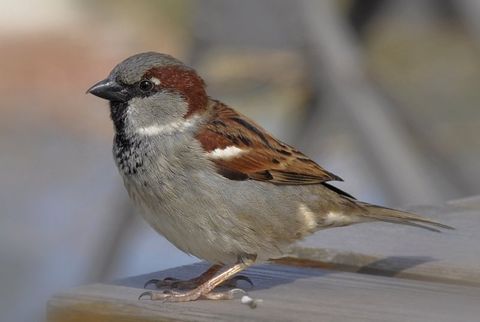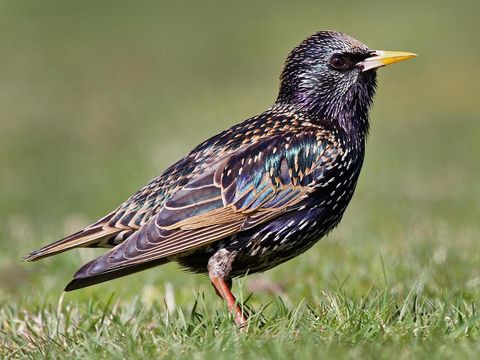House Sparrows & Starlings

The House Sparrow has driven birds like the Bluebird and Purple Martin from areas where they were once common. House Sparrows nest in bird boxes, tree holes and in almost any nook or cranny of a building. They are aggressive fighters and will evict ANY nesting bird from a cavity to take over the site. House Sparrows will tear up nests, break eggs, kill and toss out nestlings and adults and then build their nest right on top of the carnage.
Do NOT help House Sparrows to nest around your home. Buy nest boxes designed to exclude sparrows by having an opening only large enough for a Chickadee, Swallow, etc. On your existing boxes with openings over 1-1/8", install an opening adapter to reduce the opening to 1" to 1-1/8". But be sure to note that Bluebird boxes use 1-1/2" holes, which a House Sparrow CAN fit through. But there are things you can do to discourage the Sparrows. Plugging the entrance hole of a box taken over by sparrows will prevent the male from using that specific box, and might even encourage him to move elsewhere. Some people plug the entrance hole at the end of the nesting season and leave it plugged until the bluebirds arrive in the spring. This will prevent sparrows from roosting in the box during the winter, and then staking an early claim in the spring. More active techniques, such as trapping, can also be appropriate. The North American Bluebird Society has much more specific information. See http://www.nabluebirdsociety.org/sparrow.htm on the web.
Another good source of information about Bluebirds is the Sialis website at . They have an excellent page for managing and controlling House Sparrows , including tips on using monofilament fishing line to discourage them.
Regarding bird feeding, House Sparrows are very opportunistic. It is sometimes suggested to eliminate mixed bird seed from your feeders and use only sunflower, niger (thistle) and suet. But the experience of Tulsa Audubon is that House Sparrows love black oil sunflower seed and will also eat niger and suet, so selective feeding is not an effective deterrent. If you are lucky enough to have Bluebirds in your area and have a House Sparrow problem, you may want to try what one of our members does and stop feeding the birds entirely in late winter, when the Bluebirds start getting ready to nest. However, many of us don't have Bluebird habitat and want to encourage a wide variety of birds at our feeders.
Our native birds really need your help to have a place to nest that is safe from the attacks of the House Sparrow.

Whatever negative qualities a House Sparrow bears, a Starling is much worse. They also take over nesting cavities and will evict birds larger than themselves like Flickers, Wood Ducks and Kestrels. Starlings are messy, quarrelsome, aggressive, and noisy. They gather by the thousands in their winter roosts and in the Spring nest in cavities to produce 2-3 broods.
Use nest boxes that discourage Starlings. A nest box with an entrance hole of 1-1/2" or less will deter Starlings. Evict Starlings you find in your nest boxes. Starlings like dark places so having a light colored interior nest box will help discourage the Starling. Our larger native cavity nesters also really need your assistance!

